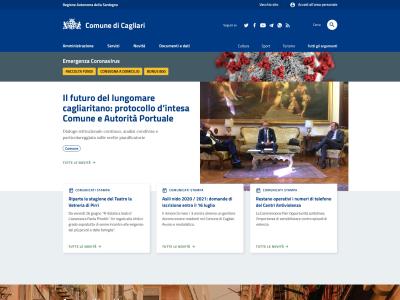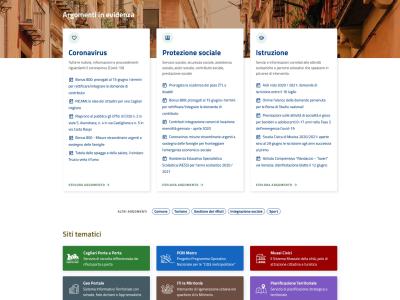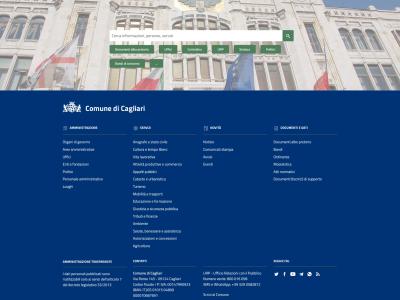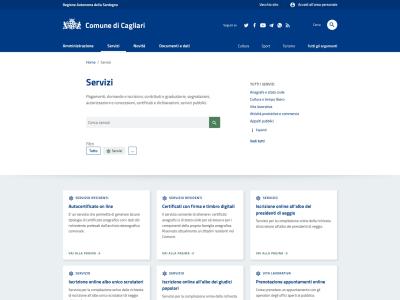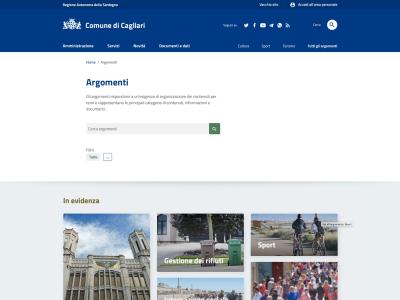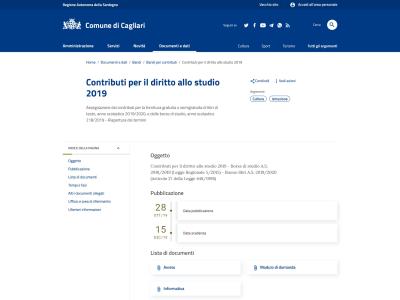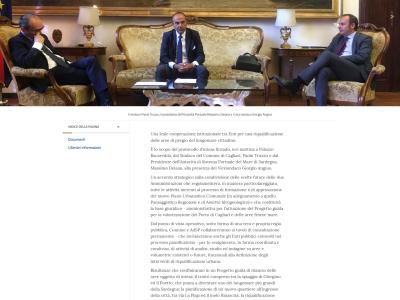Comune di Cagliari
A template for municipalities’ websites
Vitality
Quick links
Description
In December 2019, the Municipality of Cagliari published the new institutional portal provided for in the Operational Plan for Metropolitan Cities 2014-2020 (Project CA1.1.1.a.3 – Axis 1).
The project for the new portal was included among the actions carried out by the municipality on the digital agenda and in line with the three-year plan for IT in the public sector.
The municipality joined Designers Italia, the design system of the Italian public administration of AGID and the Digital Team, actively contributing to the creation of kits and the testing of a model proposing a standard for all municipalities.
The site has been designed to be
displayed on mobile devices and subsequently adapted for desktop version. The homepage provides a preview of the different types of content and an overview of the structure of the website.
The architecture that organises and classifies the information has been rethought by splitting the site into four sections: Administration, Services, Novity, Documents and Data. In addition, there is a categorisation system by topic, based on keywords that best describe the reality and life of a municipality. The content is organised in topics and hosted in thematic pages.
The portal is set up in cooperation with Enando: an Open Source Platform (Application Composition Platform) that provides all the tools and technologies needed to build modern, cloud-native and scalable applications. The portal benefits from a powerful search engine that, using the Tag based taxonomy, helps the user best to move within the new institutional website, suggesting the most appropriate content depending on the choices made.
During the design, components were created that can be used free of charge by all Italian municipalities, in line with the software reuse paradigm provided for in Article 69 of the Digital Administration Code. In addition, each administration has the possibility to customise these components as they wish. The catalogue of reused components is regularly enriched with new functionalities.
The municipality, with a strong focus on adopting enabling platforms and developing new digital services, is available to share experiences with all those interested in making their site simpler and more effective, while highlighting the importance of collaborative and sharing pathways of national relevance. Continuous discussion on these issues is very useful, enriching current experience and helping to improve what has been done so far with the help of all, in order to ensure a strategic and shared vision of services to the citizen and of the new scenarios offered by information and communication technologies.
Features
- REST API engine
- Cloud deployment ‘Native support for Kubernetes’
- Caching
- Data abstraction level
- Management of content and assets (documents, multimedia files, images)
- Editing and scheduling of content
- Classification of content (taxonomy and facet navigation)
- Georeferenced content
- Search engine optimisation (SEO)
- Access control based on Ruoli-Groups
- Identity management via Keycloak
- Compatibility with standard protocols (OpenID Connect, OAuth 2.0 and SAML 2.0) Single Sign On and Social Login
- UI/UX models based on RESTful technology
- Support for Responsive Design
- Multilingual Support
- Compliance with the design model provided for in the Guidelines for the Design of Public Administration sites and services
- Compliance with the information standards laid down in the PA’s Guidelines for the Design of Sites
- UI/UX models based on RESTful technology
- Mobile first approach, thanks to HTML5 and CSS3 standards

